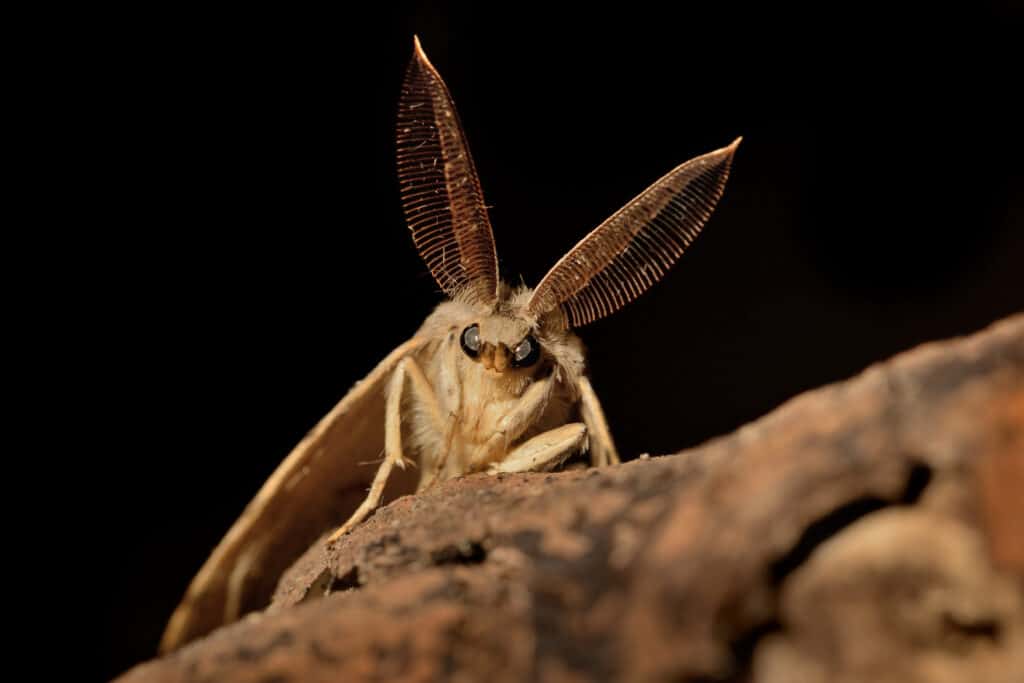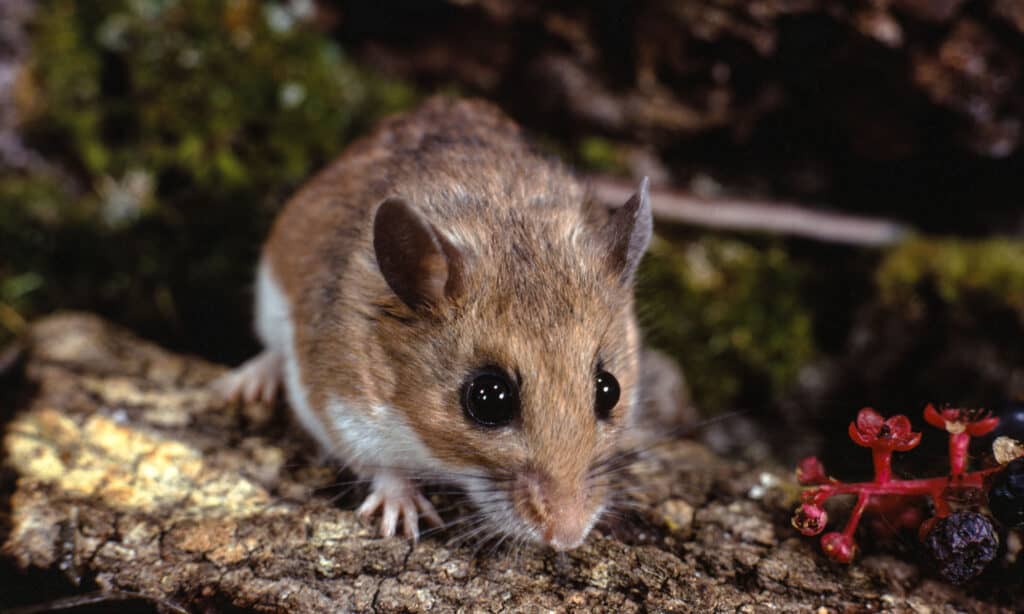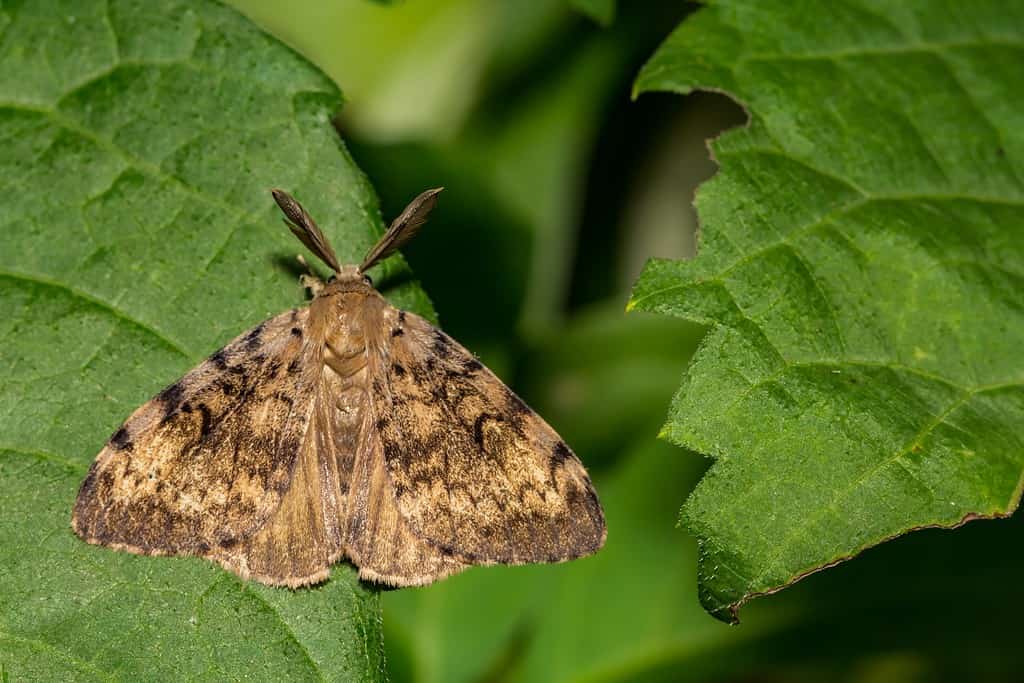Spongy Moth
Lymantria dispar dispar
In March of 2022, the Entomological Society of America changed the name of this insect from the European gypsy moth to the spongy moth out of respect for the Romani community, which considers the word "gypsy" to be offensive.
Advertisement
Spongy Moth Scientific Classification
- Kingdom
- Animalia
- Phylum
- Arthropoda
- Class
- Insecta
- Order
- Lepidoptera
- Family
- Noctuoidea
- Genus
- Erebidae
- Scientific Name
- Lymantria dispar dispar
Read our Complete Guide to Classification of Animals.
Spongy Moth Conservation Status
Spongy Moth Facts
- Name Of Young
- Caterpillar
- Group Behavior
- Largely solitary
- Fun Fact
- In March of 2022, the Entomological Society of America changed the name of this insect from the European gypsy moth to the spongy moth out of respect for the Romani community, which considers the word "gypsy" to be offensive.
- Biggest Threat
- White-footed mouse
- Predators
- White-footed mouse, northern short-tailed shrew, birds, beetles, parasites
- Diet
- Herbivore
- Lifestyle
- Nocturnal
- Favorite Food
- Foliage of hardwood trees
- Origin
- Europe
- Location
- Eastern U.S. and Canada
- Average Clutch Size
- 750
- Nesting Location
- Undersides of leaves, bark, and upright objects
Spongy Moth Physical Characteristics
- Color
- Brown
- White
- Lifespan
- 9 weeks
- Length
- About 1 inch
- Age of Sexual Maturity
- 7 weeks
View all of the Spongy Moth images!
The spongy moth, formerly known as the European gypsy moth, is a species of insect native to Europe and Africa, which has become a troublesome invasive species in North America. Its scientific name is Lymantria dispar dispar, a member of the family Erebidae. Larvae from the spongy moth consume the foliage of over 500 species of plants, including shrubs and hardwood trees.
Spongy Moth Facts
- In March of 2022, the Entomological Society of America changed the name of this insect from the European gypsy moth to the spongy moth out of respect for the Romani community, which considers the word “gypsy” to be offensive.
- Some people can develop a poison ivy-like rash from coming into contact with the caterpillar of the spongy moth.
- When there are significant outbreaks of the spongy moth, the sound of chewing and excretion can be so loud that it sounds like a light rain.
- The spongy moth is a destructive pest in the Eastern United States. It causes millions of dollars in damages annually. It is considered one of the 100 most destructive invasive species worldwide.
- Larvae are commonly referred to as tussock moths because of the tufts of hair they display.
Spongy Moth Species, Types, and Scientific Name

The spongy moth is considered one of the 100 most destructive invasive species worldwide.
©iStock.com/phototrip
Once known as the gypsy moth, the Lymantria dispar has been renamed “spongy moth” to avoid offending the Romani people. This species has three subspecies, though there is some discussion as to whether or not they are genuinely distinct from one another. The subspecies known as the European gypsy moth is now known simply as the spongy moth, the representative of the overarching species, and goes by the name Lymantria dispar dispar.
The history of Lymantria dispar goes back to Carl Linnaeus, the Swedish botanist known as the creator of modern taxonomy. He was the first to describe the species in 1758. There has been some controversy over classification over the years, as families and superfamilies have bounced between Lymantriinae, Erebidae, and Noctuidae. In addition to Lymantria dispar dispar, the species includes the subspecies Lymantria dispar asiatica and Lymantria dispar japonica.
The spongy moth’s binomial designation uses two Latin words; Lymantria is based on the word for “destroyer.” Dispar refers to a word meaning “unequal,” referring to the different characteristics between the male and female spongy moths.
Appearance: How To Identify Spongy Moths

When spongy moths first hatch they are black with hair-like bristles, then as they age, their backs develop a series of blue spots and red spots.
©iStock.com/grannyogrimm
Spongy moths can be identified at many stages: egg, larva, pupa, and adult. The clusters of eggs that the female lays are oval and measure 3/4 inch by 1 and 1/2 inches. They are the same color as manila folders, though they may pale in color during winter. They are covered by hair-like bristles, which give them a sponge-like appearance, inspiring their name.
At the larval stage, they are about 1/8 of an inch long when they first hatch and will grow to lengths of about 2 to 3 and 1/2 inches. When they first hatch they are black with what are called “setae,” which are hair-like bristles. As they age, their backs develop a series of blue spots (five pairs) and red spots (six pairs) with a few setae. Before the pupal stage begins, larvae stop eating and create a silk cover.
Spongy moth pupae are sometimes covered in a thin cocoon, but sometimes they’ll hang directly from branches or bark. The pupa itself is dark, with sparse setae emerging from the shell.
There are some differences between males and females. Females have light antennae, while those of the males are like tiny feathers. Females are also larger than males. The forewings of the males are just under an inch long, while those of the females measure up to 1 and 3/8 inches, though they cannot fly.
Habitat: Where To Find Spongy Moths

Female spongy moths will lay fuzzy clusters of about 500 eggs and after hatching, the larvae will sail on silken strands to trees to feed on.
©Beth Schroeder/Shutterstock.com
Although the spongy moth was originally native to Europe, being found throughout the continent to the Ural Mountains of Russia, down to the Middle East, the Mediterranean, and North Africa, it was introduced to North America over 150 years ago. Since then, it has taken up residence in hardwood forests of the Eastern U.S. and Canada, feasting on more than 500 species of shrubs and trees.
After mating, females will lay fuzzy clusters of about 500 eggs on just about anything upright, including shrubs, trees, cars, and rocks. The fuzz on these clusters can cause rashes, like the hairs, on the larvae. After hatching, the larvae will sail on silken strands to trees to feed on. At first, feeding will occur during the daytime on the hairs of the leaf and then on the epidermis. As they age, they will begin to feed at night, hiding away under leaves, bark, branches, or other protection. If there are not many moths in the area, larvae will pupate in the sheltered areas of their night feeding. If numbers are high, they will pupate anywhere, even open locations.
After emerging from their cocoons, moths will mostly limit their activity to night, as they are nocturnal. Males can be found flying up and down objects searching for females.
Evolution and History of Spongy Moths
The spongy moth belongs to the order Lepidoptera, which is the same order that includes butterflies. Lepidoptera have co-evolved with plants and predators over millions of years, taking their place between the plants which create their food with photosynthesis and predators which cannot.
The spongy moth was native to Europe until it was introduced in 1868 to the United States by Etienne Trouvelot, a French scientist trying to create a hybrid species of silk-spinning caterpillar. Some moths in captivity escaped and began their slow progression through the Eastern regions of the United States and Canada. It is now devastating trees within that region.
Within 20 years, infestations began occurring in New England. By 1923, a barrier zone was attempted from Canada to New York, but by 1939, the infestation spread beyond the barrier. The spongy moth had spread through the Northeastern U.S. to Ontario and Quebec. It has now spread through the Virginias to Illinois, Michigan, Minnesota, and Wisconsin. There have been some outbreaks in the Pacific Northwest, but steps have been taken to eliminate them.
The female spongy moth is unable to fly. This has slowed its spread in the Eastern U.S. and Canada over the last 150 years. With limited flight as a species, the spongy moth can travel via two methods. Over short distances, recently hatched larvae can float on air currents on short strands of spun silk, the way some spiders travel.
The majority of travel, however, is due to human migration. Moths attach themselves to vehicles, firewood, and outdoor furniture. Approximately 85 percent of new outbreaks have resulted from this kind of movement.
Diet: What Do Spongy Moths Eat?
The spongy moth plays a pivotal ecological role, bridging plants that convert energy to food through photosynthesis and predators that rely on animals that take in that energy.
What Eats the Spongy Moth?

The common white-footed mouse will eat larval or pupal moths sheltering near the ground.
©iStock.com/Weber
Some predators or threats are better than others at controlling the spongy moth population. Rodents like the common white-footed mouse will eat larval or pupal moths sheltering near the ground. Another mammal that consumes spongy moth larvae and pupae is the northern short-tailed shrew. A variety of birds eat the larva of the spongy moth, including the blue jay, the northern oriole, the European robin, and the black-capped chickadee, but their impact on the moth population is not well known. The forest caterpillar hunter is a beetle that eats the larvae and pupae of the spongy moth and has an impact on limited populations. Several parasitic flies and wasps can attack and inhabit the eggs before the larval stage, as well as a few that can affect the larvae and pupae, but their impact is limited.
In addition to the predators and parasites above, viruses, bacteria, and fungi can kill the spongy moth. The Japanese fungus, Entomophaga maimaiga, has been shown to impact the population of the spongy moth. It was tried as early as 1910 in North America but wasn’t used effectively until the 1980s.
What Does the Spongy Moth Eat?
Spongy moth larvae will feed on many hardwood and conifer trees and shrubs but prefer oak trees. Aspen, apple, birch, poplar, and willow in the Eastern U.S. are also favorites. There are a few trees that the spongy moth will avoid, including sycamore, black walnut, butternut, flowering dogwood, and cedar, among others. However, they may feed on these during later development stages when food is scarce due to overpopulation. Also, older larvae may feed on softwoods, which younger ones usually avoid.
Prevention: How to Get Rid of Spongy Moths

The spongy moth is responsible for extensive defoliation in the Eastern United States.
©Jay Ondreicka/Shutterstock.com
The spongy moth is responsible for extensive defoliation in the Eastern U.S. In the 40 years after 1970, the spongy moth destroyed over 80 million acres and cost the economy millions of dollars. Nearly 13 million acres were lost in 1981 alone.
In attempts to control the spongy moth, parasitic and predatory flies and wasps were introduced with mixed success starting in the late 1800s. Some of these species attacked and decimated native species, causing more environmental harm than help. The best agents introduced were viruses and fungi, the most effective of which was Entomophaga maimaiga, a Japanese fungus.
Other ways of controlling the spongy moth include:
- Destroying egg masses found on buildings, vehicles, and other structures during regular examinations. They can be crushed or placed in containers of soapy water or kerosene.
- Burlap placed around the trunks of trees may crush larvae and pupae when populations are small.
- Barrier bands, such as grease, or double-sided tape, can be placed on duct tape to keep larvae from climbing up vulnerable trees.
- Sometimes, an insecticide might be required if there’s a large infestation.
- Avoid moving firewood.
- Finally, properly care for your trees to keep them from being stressed. Pests will usually attack stressed trees first, so properly water, fertilize, and mulch them.
Spongy Moth FAQs (Frequently Asked Questions)
Why is the spongy moth a problem?
In the United States, the spongy moth is an invasive species. It feeds on over 300 trees and shrubs, preferring a variety of hardwood trees, causing deforestation throughout the eastern portions of the U.S. and Canada.
Are spongy moths poisonous?
Spongy moths are not poisonous. However, coming into contact with the hairs of the larval form can cause a poison-ivy like rash.
What keeps spongy moths away?
To slow down the spread of the spongy moth population: destroy masses of eggs found during regular examinations on buildings and vehicles, place burlap around the trunks of vulnerable trees to crush larvae, place barrier bands around trees, don’t move firewood across community borders, and maintain healthy trees.
What kills spongy moths?
Insecticides can kill spongy moths. The Japanese fungus, Entomophaga maimaiga, as well as a variety of parasites, can also kill spongy moths.
Do any birds eat spongy moth caterpillars?
Spongy moth larvae, pupae, and adults are preyed upon by the blue jay, northern oriole, black-capped chickadee, and European robin, among others.
Thank you for reading! Have some feedback for us? Contact the AZ Animals editorial team.
Sources
- Wikipedia, Available here: https://en.wikipedia.org/wiki/Lymantria_dispar_dispar
- Wikipedia, Available here: https://en.wikipedia.org/wiki/Lymantria_dispar
- Wikipedia, Available here: https://en.wikipedia.org/wiki/Gypsy_moths_in_the_United_States
- Invasive Species Centre, Available here: https://www.invasivespeciescentre.ca/invasive-species/meet-the-species/invasive-insects/gypsy-moth/
- Entomology at the University of Kentucky, Available here: https://entomology.ca.uky.edu/ef425
- NatureServe Explorer, Available here: https://explorer.natureserve.org/Taxon/ELEMENT_GLOBAL.2.1193036/Lymantria_dispar_dispar
- Jing Zhang, Qian Cong, Emily A. Rex, Winnie Hallwachs, Daniel H. Janzen, Nick V. Grishin, and Don B. Gammon, Gypsy moth genome provides insights into flight capability and virus–host interactions, 2019/01/29 10.1073/pnas.1818283116 Proceedings of the National Academy of Sciences, Available here: https://www.pnas.org/doi/10.1073/pnas.1818283116
- Wikipedia, Available here: https://en.wikipedia.org/wiki/Lepidoptera

















